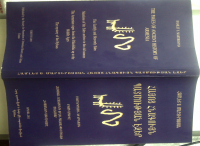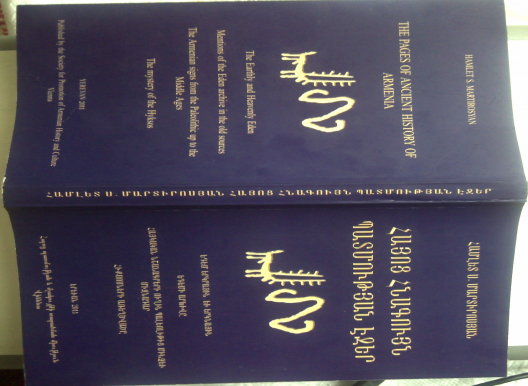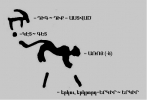THE PAGES OF ANCIENT HISTORY OF ARMENIA (SUMMARY) by HAMLET MARTIROSYAN
 “The Pages of Ancient History of Armenia” includes four independent research works:
“The Pages of Ancient History of Armenia” includes four independent research works:
1. The Earthly and Heavenly Eden - In the following work an attempt of defining precise location of the Garden of Eden is made. The Garden of Eden is called Gan ‘Eden in the original Book of Genesis, where the word “gan” means “garden”. At the same time there are kAn, kAn.w= “vineyard, garden” in Egyptian, and gana2/kana2= “field; farm, plantation” in Sumerian (Akkadian eqlu, meristu). The respective word also exists in Armenian in the form of “kana”. According to the cherished tradition of the Armenian agriculture, when a vineyard is planted, the grapevines are called “mat” in the first year, “shishak” in the second year, and “qoq” in the third and fourth years. The grapevines start to yield partially in the fourth year. In order the soil not to lie idle during those years, the beds are also used for raising vegetable crops until they become a full-grown garden. Armenians call the garden “kana” in its fourth and fifth years (the first and second years of crop) after planting the grapevines. In other words, “kana” is called the garden that yields vegetable and fruit crops simultaneously. Since the third year of harvest kana is renamed aigi (egi, eqi) - ‘garden” that gives only fruit crop. From that year on the fertile grapevine is called “mov”.
This peculiar technology of vineyard cultivation, as well as the ar-chaeological data (particularly the 4th millennium B.C. wine jars and grape stones discovered in the Areni I cave) witness that gardening and the name “kana” have local and ancient derivation. The Sumerian sign GAN, from which derives a cuneiform read as gana2/kana2, precisely corresponds to the irrigation layout view of kana.
The constellation of the Square of Pegasus (MULkana2/MULgana2) was also called gana2/kana2= “field, garden” in Sumerian and described as a “Holy Habitation of Haia God”, i.e. represented the Garden of heavenly Eden. More frequently the constellation name was written along with the AS cuneiform (MULas-kana2/ MULas-gana2). The Sumerian AS cuneiform has a “perfect” meaning and is read as as, az3, as3. The Armenian analogues for these are (h)as= “matured, perfect”. The compound word as- kana2=as-gana2=askana= “perfect garden” is seen in the name Askanaz, mentioned in the Book of Genesis. Askanaz, as a compound personal name that carries a meaning, is composed of “askana” (with conjugation, coupling of k>q in “asqana”) and the words “az, azn”. The word “az, azn” has a meaning of “nation, tribe, kin, generation” in Armenian. Therefore, the name Askanaz would mean “the tribe of askana”. Since derivation of the manuscripts, written using Mashtotsian alphabet (created by Mesrop Mashtots), the Armenian authors have called the Armenians as descendants of Askanaz and Torgom, two grandsons of Habet. Koryun, the author of the manuscript “The Life of Mashtots” (the 5th century) starts his story as follows: “About the God-given alphabet of the Askanazian nation and the land of Armenia...”. Koryun calls the nation “Askanazian” and the state Armenia. The same definition can also be found in the work of the prophet Jeremiah, who lived thousand years prior to Koryun. Here “the Araratian kingdoms” also imply the state, and “Askanazian regiment” stands for the nation of that state, since in Armenian, as well as in many other languages, the words “regiment, troops” mean both “army” and “nation, people”.
Many researchers have fairly identified the ‘Eden component of the name Gan ‘Eden with the Sumerian word edin/eden. With its meanings and form of writing the word edin=e-din=e-tin=i3-ti-nu4 =“back, the upper side, up” accurately coincides with the Armenian word yetin/yedin = “the back side, after”. The idea of back, upper, upper side was identified with the North in the Ancient world, because the orientation was towards the South. Thus, Gan ‘Eden = “the upper garden” might have meant both “garden to the North from Sumer”, as well as “heavenly garden”. The Sumerian toponyms Ni-tuk10 and DilmunKI are discussed as names of the earthly Eden and analogues for Gan ‘Eden. In addition, their etymologies and meanings are suggested on the basis of Armenian.
In real geography the names of the rivers (Euphrates, Tigris, Gehon and Pison) that rise in Eden are of a great importance for localization of the Eden. The cuneiform pairs (ID2U4.KIB.NUNki, ID2MAS.GU2.GAR3, ge-ha-an, pisan2) of these rivemames are suggested, which are etymologized in Armenian and identified with the rivers of the Armenian Highland, namely Euphrates, Tigris, Arax and Chorokh.
2. Mentions of the Eden archive in the old sources - The results of the preliminary research have shown that the pictograms, found in the Syunik region of the RA, represent a writing system of ideograms, created not later than in the 12th millennium B.C. Moreover, it was found out that there are hundreds of Sumerian and Egyptian signs in the pictograms of Syunik (see Appendix 1 and Appendix 2). The published Sumerian and Egyptian written sources do not provide direct geographical indications about the primary place of origin of the written language. But such indications are found in the Book of Jubilees and the Book of Genesis, roots of which go to Mesopotamia. According to the Book of Jubilees, Noah’s ark rested on the top of the mountain Lubar of the Ararat country. Noah’s offspring settled and bred in the neighborhood of the mountain Lubar. One of them Kayinan was looking for a place where he might found his city, and in the course of his search: “He found a writing, which former had carved on the rock, and he read what was thereon, and he transcribed it and discovered that it contained the teaching of the Watchers about the omens of the sun and moon and stars in all the signs of heaven”. Hence, this is the precise exposition of Syu- nik’s pictograms.
In the Armenian translation of the Genesis (the 5th century) it is said: “And the Ark rested on the Araratian Mountains”, but unlike the Book of Jubilees* a name of a proper mountain is not mentioned. Subsequently, enumerating the names of Yektan’s sons, the Book of Genesis states that: “And their dwelling was from Maseats, as thou goest unto Sovpera, a mount of the east”. From this short passage of the Book of Genesis the toponyms “Maseats” and “Sovpera”, which are not mentioned elsewhere, become our subject of consideration. Scientists are uncertain about identification of these toponyms, and their precise location is unknown to the present days.
St. Mesrop Mashtots and St. Sahak Partev, while translating the Book of Genesis, interpreted the Greek toponym MOKJOTI as Maseats, which in Armenian literally means “from the (Great and Small) Masis Mountains”. This mountain is known worldwide as Ararat. If the western border of the residence area of Yektan and his 13 sons was Masis, the mountain of Salvation, then there were the mountains of Syunik with their pictograms to the East from them. The Book of Genesis mentions Syunik in form of Soper (Sovper, Sopar, Sopor), since this word with its Semitic origin means “writing” (in Assyrian sefra = “writing, book”, safra = “writer”, in Hebrew spr, sfr = “to retell, count, write”, sofer = “writer”, in Aramean safra = “writer”, Arabic sifr = “book”, etc.). Therefore, the phrase “Soper Mountain” in the Book of Genesis literally means “the mountain of the writings” and indicates Syunik with its pre- Flood pictograms.
3.The Armenian signs from the Paleolithic up to the Middle Ages -The usage of the symbol that resembles to the Greek capital letter Omega (Զ) is found in Sumer and Egyptian pictography. This symbol was the ideogram standing for the name of Ninhursag Mother Goddess in Sumer and the name of Mother Goddess Mwt in Egypt. Babylonian Goddess Sassuru corresponds to the Sumer Goddess Ninhursag, which literally means “womb”.
The forms of writing the name of Goddess Mwt are the key to explore phonetic value and meaning of the Omega symbol. It is written both in the form of the symbol Omega as well as in the form of hieroglyph depicting kite (c’in) bird. This predator bird does not have any other merit, rather than her name to stand for the ideogram of the Mother Goddess, and the link between the Mother Goddess and the bird is provided by the Armenian language. In Armenian the name “c’in” (=kite) is homonymic to the word cin=“to give birth; womb, placenta”, which expresses the core notion of giving birth and the two important organs for delivering birth (womb and placenta). Therefore it is assumed that the ideogram standing for the name of the Mother Goddess with the image of the c’in bird is done through Armenian homonyms. As a result the reading of cin should be ascribed to the symbol Omega, which graphically depicts the feminine organ (vulva) and the womb together; i.e. depicts the entire organ of delivering birth.
The ancient samples of the symbol “cin” trace back to the Upper Paleolithic era and can be found on the pictograms of Syunik ( ). In the territory of Armenia this symbol has continuously been used since the Upper Paleolithic era to the present days. It exists in the lists of medieval symbols, church architecture, on cross-stones, in carpet making etc.
4.The mystery of the Hyksos -The traces left in Egypt by the indigenes from the Armenian Highland are concisely discussed according to the eras. The first wave of the indigenes from the Armenian Highland introduced in Egypt the domesticated goat, which is seen on the Egyptian pictograms. The pictograms with the image of the goat are discovered throughout the way from Syunik to the basin of the Lake Van- Palestine- Negev- Egypt. The most ancient of these are the pictograms of Syunik, dated to the Upper Paleolithic era. Based on the existing archaeological data about appearance of the domesticated goat in the region, the pictograms of Palestine and Negev are dated back to the 10-9th millennia B.C. Finally, the Egyptian pictograms are dated back
to the 7-6th millennia B.C. Taking into account that domestication of the goat was implemented in Armenia and the pictograms of Syunik were carved not later than in the 12th millennium B.C., it can be stated that the first tiller-graziers entering Egypt were from the Armenian Highland.
Concise reference is also made to the subsequent emigration waves of the Armenian indigenes to Egypt in the second half of the 4th and beginning of the 3rd millennia B.C., as well as to the archaeological data certifying the latter.
Then, raids from Armenia to Egypt that took place during the first and second transition periods of Egypt are comprehensively discussed. A viewpoint is raised that the bellicose Semitic tribes that had invaded Palestine and Northern Mesopotamia during the first and second transition periods blocked the trade channels Armenia-Egypt and Armenia- Sumer. The abovementioned raids were aimed at reopening of those commercial channels and ensuring their security. For the very reason, raids were organized both to Egypt (first transition period, the Hyksos), and simultaneously to Mesopotamia (the Kutians, Kassits).
The interpretation given to the name “Hyksos” as hyk= “king” and sos= “shepherd” by Maneton are thoroughly considered here. Taking the meaning of “religious leader, priest” for the word “shepherd”, the name “Hyksos” gains the meaning of “kinq-priest”, “warrior-priest”, and the data from the Sumerian, Egyptian, Hittite, Urartian, Greek, Armenian written sources are witnessed to prove that idea. Also the possibility of etymologizing the names Kassit and Hyksos in Armenian is discussed, and those are proved to be synonyms formed on the basis of Armenian.
The name “Avaris”, the Hyksos capital in Egypt, is also etymologized in Armenian, and the toponyms in Armenia, containing the word “avar”, are brought, among which is Avaris residence of Mokq land in the Great Armenia. In the early medieval manuscripts the name of an unknown animal “long-jaw Avaros” is mentioned, which can be the strange animal depicted in the hieroglyph that stands for the name of God Set. On the other hand, the images of the unknown animal depicted in the hieroglyph are found in the Upper Paleolithic pictograms of Syunik.
Set was proclaimed the Supreme God by the Hyksos in Egypt, and discovery of genealogical roots of the name and cult of God Set are essential for understanding the mystery of the Hyksos. The Armenian etymologies of hieroglyphic forms of writing of god Set’s name are brought, and it’s proved that only on the bases of the Armenian homonyms the ideograms of the mythological name were possible to form For instance, the name Set is occasionally written with the ideogram ('Ш. ) that stands for “hair” and “tail”. In Egyptian the words that mean “tail” and “hair”, as well as the name Set are homonyms written in the same way: st, st, sd = ° ^T”, IK = “hair; tail”. This is a
kind of rebus that helps to define in which language the words meaning “tail” and “hair” with homonymous and consonantal variant of writing have the form of st or zt.
However, the Armenian language provides the key to this rebus, because we have stew= “wool, hair”, sti= “hairy, lanate” and zet= “tail, particularly, hairy tail” in Armenian. Moreover, the form “sti” precisely corresponds to the Egyptian form of writing of sti= - «Obviously, these words along with their consonantal form of writing (st/zt) are exactly identical with the Egyptian word st/zt that stands for “tail” and “hair”, which in concert with the determinant “god” also expresses the name of God Set. Certainly, the word “st”, meaning “tail” and “hair”, has no connection with the meaning of the mythological name Set. The mythological name Set was hieroglyphied and read with this word, as a graphic image, on the principal of homonyms. And the meaning of the god name Set is linked to another word stem “st-”, which forms the words stewol = “creator”, stel(§) = “to create” in Armenian, by adding the particles “-ol /-el” to it. Therefore, it can be stated that in accordance with the data of the Armenian language the Egyptian god name Stew means “creator”.
The names of the Hyksos pharaohs (mentioned by Maneton, as well as testified by hieroglyphic writings) are also considered here. These names are etymologized on the bases of the Armenian language too.
As stated in the traditional chronology, the Armenian king Aram ruled during the period between the ends of the 19th - first quarter of the 18th century B.C. The results of the comparative analysis of the data about king Aram from “The History of Armenia” by Movses Khorenatsi, the contemporary historiographic data, the stories about the Hebrew patriarchs from the Old Testament and the data from Armenian epos prove that:
1.The southern rival of King Aram, Barsham, is historical Shamshi Adad I, and his raid to Mesopotamia corresponds to the invasion of the Kassits.
2.Aram’s raid in the South-Western direction against Payapis Qaafyan corresponds to the Hyksos invasion of Egypt.
3.According to the chronology of Movses Khorenatsi, the Hebrew Patriarch Abraham is a contemporary of Aram. The road passed by Abraham from Kharan to Egypt is both geographically and chronologically consistent with the way passed by the Hyksos.


• ՀՈԴՎԱԾՆԵՐԸ ՄԱՍՆԱԿԻ ԿԱՄ ԱՄԲՈՂՋՈՒԹՅԱՄԲ ԱՐՏԱՏՊԵԼՈՒ ԿԱՄ ՕԳՏԱԳՈՐԾԵԼՈՒ ԴԵՊՔՈՒՄ ՀՂՈՒՄԸ www.anunner.com ԿԱՅՔԻՆ ՊԱՐՏԱԴԻՐ Է :
• ԵԹԵ ԴՈՒՔ ՈՒՆԵՔ ՍՈՒՅՆ ՀՈԴՎԱԾԸ ԼՐԱՑՆՈՂ ՀԱՎԱՍՏԻ ՏԵՂԵԿՈՒԹՅՈՒՆՆԵՐ ԵՎ
ԼՈՒՍԱՆԿԱՐՆԵՐ,ԽՆԴՐՈՒՄ ԵՆՔ ՈՒՂԱՐԿԵԼ ԴՐԱՆՔ info@anunner.com ԷԼ. ՓՈՍՏԻՆ:
• ԵԹԵ ՆԿԱՏԵԼ ԵՔ ՎՐԻՊԱԿ ԿԱՄ ԱՆՀԱՄԱՊԱՏԱՍԽԱՆՈՒԹՅՈՒՆ, ԽՆԴՐՈՒՄ ԵՆՔ ՏԵՂԵԿԱՑՆԵԼ ՄԵԶ` info@anunner.com:
| Կիսվել : |
 03:59
03:59 19:36
19:36 Այս աշխատանքը նվիրված է Սիսիան քաղաքից 3կմ հեռավորության վրա գտնվող մեգալիթյան կառույցին, որի պաշտոնական անվանումն է Զօրաց քարեր, իսկ գիտա-մասսայական գրականության և լրատվական միջոցների հրապարակած նյութերում առավելապես հայտնի է Քարահունջ անունով:...
Այս աշխատանքը նվիրված է Սիսիան քաղաքից 3կմ հեռավորության վրա գտնվող մեգալիթյան կառույցին, որի պաշտոնական անվանումն է Զօրաց քարեր, իսկ գիտա-մասսայական գրականության և լրատվական միջոցների հրապարակած նյութերում առավելապես հայտնի է Քարահունջ անունով:...
 18:05
18:05.jpg) ՀԵՌԱԿԱ ԵՐԿԽՈՍՈՒԹՅՈՒՆ ՏԵՐ ԱՍՈՂԻԿ ԿԱՐԱՊԵՏՅԱՆԻ ՀԵՏ կամ ԽԵԼՔ ՍՈՎՈՐԵՑՆԵԼՈՒՑ ԱՌԱՋ ՀԱՐԿ Է ԽԵԼՔ ՀԱՎԱՔԵԼ - Խոստմանս համաձայն, սիրով և ամենայն պատասխանատվությամբ, անդրադառնում ենք մեր հեռուստահարցազրույցի ձայնագրությունից կտրված և օրեր առաջ շրջանառության մեջ դրված այն հատվածին, որը, երբ հատվում է զրույցի թեմայի ամբողջականությունից, ինքնին դառնում է անհասկանալի: (Տեր Ասողիկ Կարապետյան...
ՀԵՌԱԿԱ ԵՐԿԽՈՍՈՒԹՅՈՒՆ ՏԵՐ ԱՍՈՂԻԿ ԿԱՐԱՊԵՏՅԱՆԻ ՀԵՏ կամ ԽԵԼՔ ՍՈՎՈՐԵՑՆԵԼՈՒՑ ԱՌԱՋ ՀԱՐԿ Է ԽԵԼՔ ՀԱՎԱՔԵԼ - Խոստմանս համաձայն, սիրով և ամենայն պատասխանատվությամբ, անդրադառնում ենք մեր հեռուստահարցազրույցի ձայնագրությունից կտրված և օրեր առաջ շրջանառության մեջ դրված այն հատվածին, որը, երբ հատվում է զրույցի թեմայի ամբողջականությունից, ինքնին դառնում է անհասկանալի: (Տեր Ասողիկ Կարապետյան...
 11:36
11:36 «Առյուծ» նշանագրի քննության ժամանակ պարզեցինք, որ Սյունիքի ժայռապատկերներում կետի և առյուծի պատկերներով գաղափարագրվել է գետառ=«մայր գետ» բառը, իսկ թևավոր առյուծի (չշփոթել անգղառյուծի հետ) պատկերով գաղափարագրվել է հոմանիշ հաւառի=«մայր գետ» բառը:
Շումերերենում հայերեն1 «գետ» բառի գրության մի ձևին անդրադարձել ենք վերը: Այժմ դառնանք գետ=«գետ, ջրի հոսանք» բառի վանկագիր ki-ta=ke-ta=ge5-ta=gi5-ta=kita/keta/geta/gita գրելաձևին: Այս բառը շումերերենում ունի «ցածը, ներքևը, տակը, խորքը» իմաստ (աքքադ. šaplū...
«Առյուծ» նշանագրի քննության ժամանակ պարզեցինք, որ Սյունիքի ժայռապատկերներում կետի և առյուծի պատկերներով գաղափարագրվել է գետառ=«մայր գետ» բառը, իսկ թևավոր առյուծի (չշփոթել անգղառյուծի հետ) պատկերով գաղափարագրվել է հոմանիշ հաւառի=«մայր գետ» բառը:
Շումերերենում հայերեն1 «գետ» բառի գրության մի ձևին անդրադարձել ենք վերը: Այժմ դառնանք գետ=«գետ, ջրի հոսանք» բառի վանկագիր ki-ta=ke-ta=ge5-ta=gi5-ta=kita/keta/geta/gita գրելաձևին: Այս բառը շումերերենում ունի «ցածը, ներքևը, տակը, խորքը» իմաստ (աքքադ. šaplū...
 14:32
14:32 Առաջին անգամ Հայոց Տունը լուրջ աքցանի մեջ առնվեց, երբ մեզնից արևելք ստեղծվեց պարթևական պետությունը, իսկ արևմուտքից Հայաստանի սահմաններին հասավ հռոմեական կայսրությունը: Լուծումներ փնտրող ազգի վերնախավը համախմբվելու փոխարեն երկփեղկվեց, կիսվեց երկու հակառակ ճամբարների՝ պարթևական կողմնորոշում և հռոմեական կողմնորոշում ունեցողների: Արդյունքում վերացավ Հայկազեան բնիկ հարստությունը (դինաստիան) և Հայստանի գահին բազմեցին պարթև Արշակունիները: Սասանյան Պարսկաստան-Բյուզանդիա աքցանի մեջ առնված Հայաստանն անմիա...
Առաջին անգամ Հայոց Տունը լուրջ աքցանի մեջ առնվեց, երբ մեզնից արևելք ստեղծվեց պարթևական պետությունը, իսկ արևմուտքից Հայաստանի սահմաններին հասավ հռոմեական կայսրությունը: Լուծումներ փնտրող ազգի վերնախավը համախմբվելու փոխարեն երկփեղկվեց, կիսվեց երկու հակառակ ճամբարների՝ պարթևական կողմնորոշում և հռոմեական կողմնորոշում ունեցողների: Արդյունքում վերացավ Հայկազեան բնիկ հարստությունը (դինաստիան) և Հայստանի գահին բազմեցին պարթև Արշակունիները: Սասանյան Պարսկաստան-Բյուզանդիա աքցանի մեջ առնված Հայաստանն անմիա...













 Arian AMU
Arian AMU
